Glovoscapes: The Street as a Shop – New Barcelona Design District
Glovoscapes is a project about retail in Eixample, Barcelona. The aim is to enhance local retailers access to the advantages of digitization of their business having Glovo as their online platform. The project focus on an area of Sant Antoni where “Streets as a Shop” intervention was further developed aggregating creative retail clusters to create urban interventions that would enhance the shopping experience as well as the online by using the Glovo platform. Therefore, retail improves in the neighborhood and a new Design District area is created acting as a point of attraction in the city and having temporary events.
Glovo
Glovo is a company which has a big presence in retail at a neighborhood scale. Its business model works within the city, delivering its products within so promoting local business. It has well established last mile distribution solutions and knows its consumer trends and habits and this aiming to connect cities to citzens.
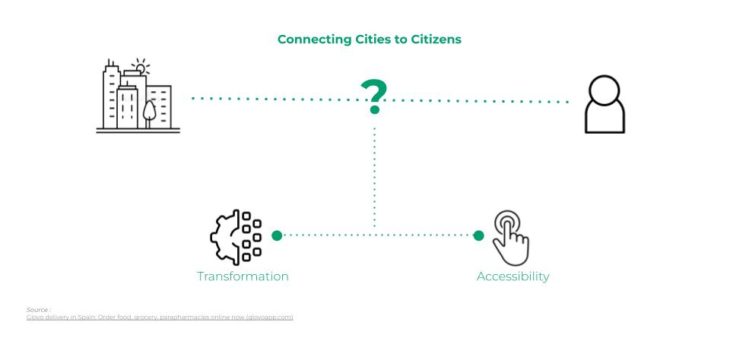
Retail in Barcelona
Eixample faced the highest impact due to the pandemic which is 59,4% of Retail
It is expected that between 10% and 15% of the commercial fabric of the city of Barcelona will not survive
Consumer Behaviour
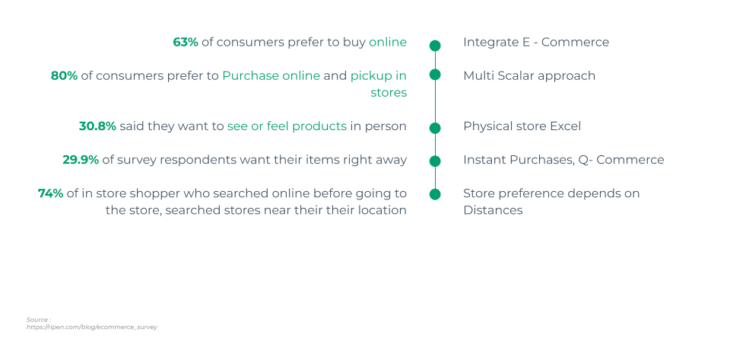
The figures about retail and consumer behaviour define a clear trend of more people buying online, however physical stores will still be need. So, there’s a clear need to adapt and update local store models to the digital process.
The Street as a Shop
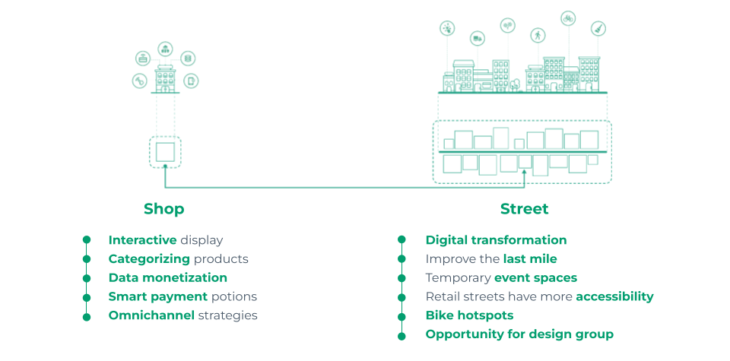
By implementing this ideas simultaneously on shops and streets the retail in the city is enhanced. A shop will improve its revenue and reach with the above improvements. Similarly, to improve a cluster of shops in a particular neighbourhood the entire street needs to be treated as a shop. The streetscapes should be part of the shopping experience by providing more walkable, accessible and lively streets.
It’s ability to change also allows the street to host temporary events related to stores of creative products and design.
Glovo acts as a catalyst to promote the retail sector by providing a platform to reach more users, last mile solutions and data monetization solutions.
This way, the project aims to expand Glovo to the retail sector; improve local store business model and enhance its presence physically and digitally; have streets as a shop in the superblock plan (making more efficient Glovo presence in the public space and activating streets and creating new dynamics that potentiate the local business); create opportunities to small companies to be as competitive as big ones; improve and increase efficiency of the Last Mile Distribution system.
Project Framework
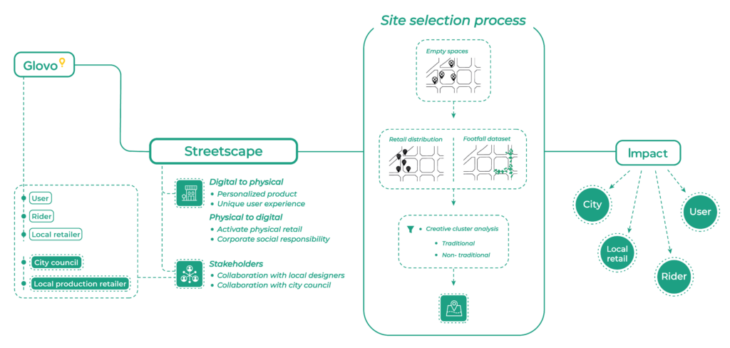
Qualitative Analysis
To understand better the needs of creative retailers and Glovo we developed a qualitative analysis.
We did a meeting with Glovo in which we understood the company commitment to support local business and to have positive social impact. We also realized other strategies that the company uses in other countries that was more similar to our case and how it could work in Barcelona also by knowing how some retail categories already function today.
By doing some interviews to local creative retailers in a weekend market and in stores in Barcelona we conclude that there are different types of creators with different presences in the retail sector. Some have their own working and selling space, others use co-working spaces and the market as selling platform and others just create at home. However, all of them already have some kind of online presence. When confronted about the idea of having co-working studios where they could work and sell and be directly connected to a online platform like Glovo, the replies were very positive and only showing some concern about eventual special workstations.
Quantitative Analysis
For the site selection we used a methodology based on analyzing and combining retail activities and footfall data.
Retail Type
Representation of the local retail data, categorized by 7 types of retail distributed in Eixample.
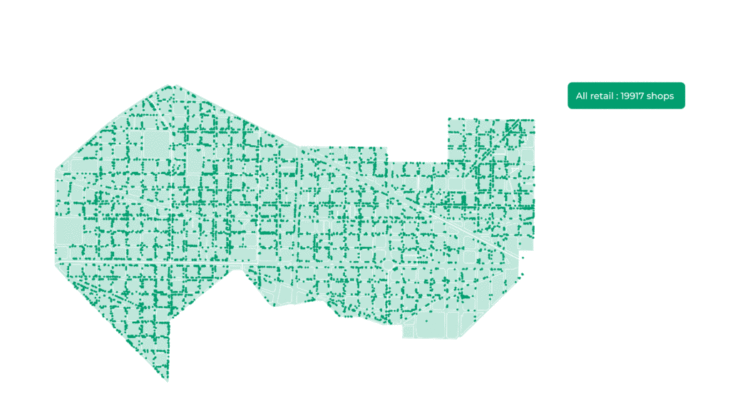
Retail Distribution according to buildings
Representation of the local retail density close to each building. 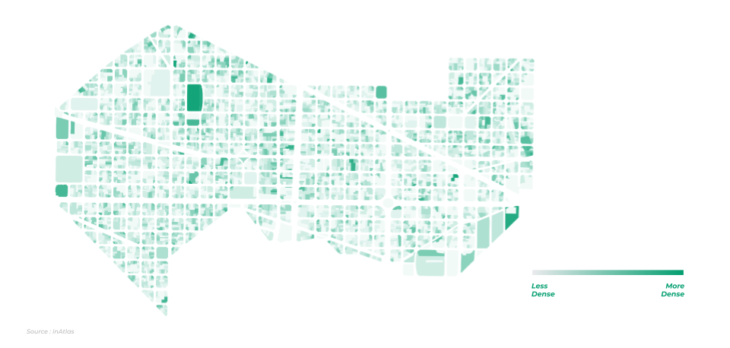
Retail Footfall Trajectory Analysis
Parallel with retail activities data, we check the footfall data as their trajectory. By weekday and weekend, dividing with 6 divisions of weekday and weekend.
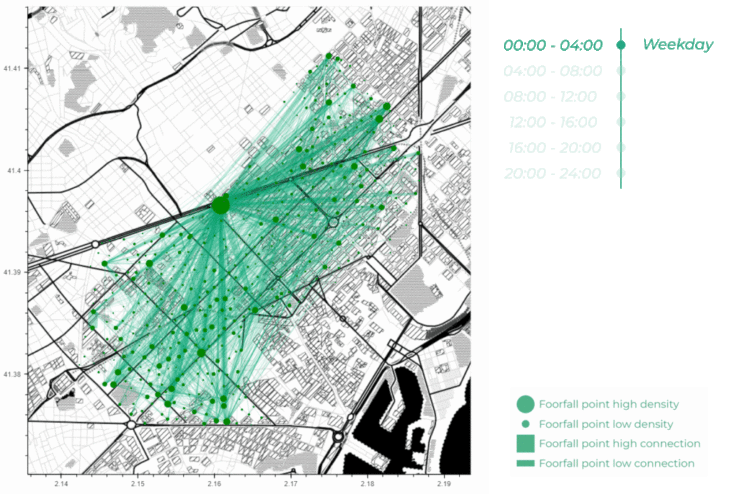
Site Selection
To proceed with the site selection, less retail and more footfall areas were considered as the areas of interest due to more potential for investment opportunities, creation of new markets and business growth.
Also, more retail and less footfall areas can be explored as opportunities and possibilities of using existing infrastructure.
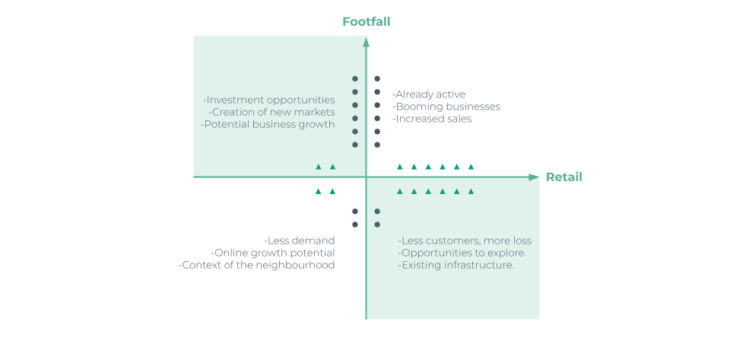
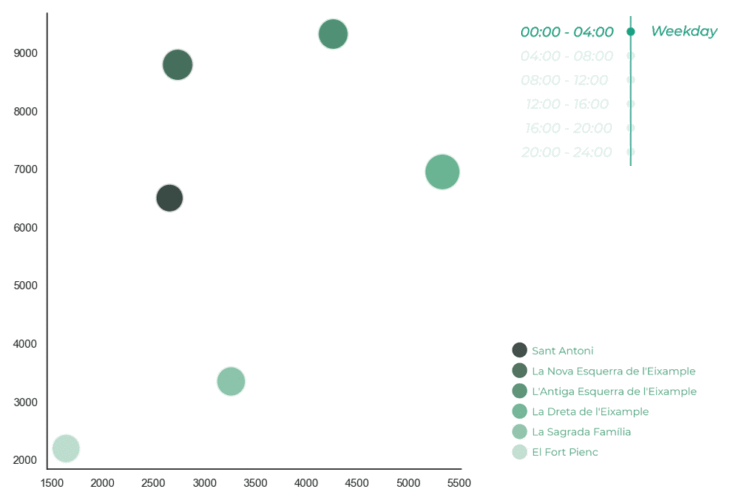
Taxonomy of Design
To relate the city retail with on of the characteristics that the city is internationally know which is Design, we created an taxonomy to identify which activity clusters could be promoted through the enhanced shopping experience of the Street as a Shop proposal. 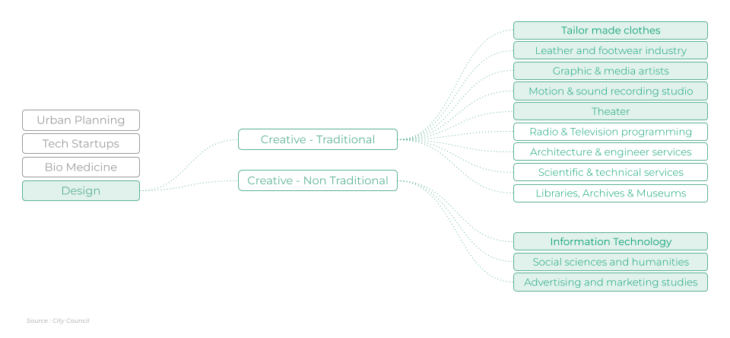
Creative Clusters in Barcelona
Identification of creative activities by traditional and non-traditional.
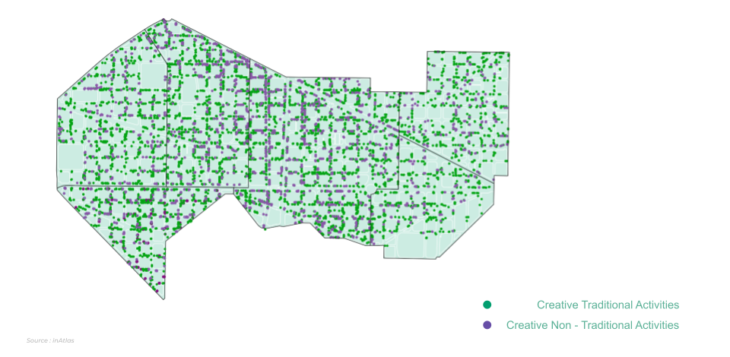
Distribution of creative activities in Eixample.
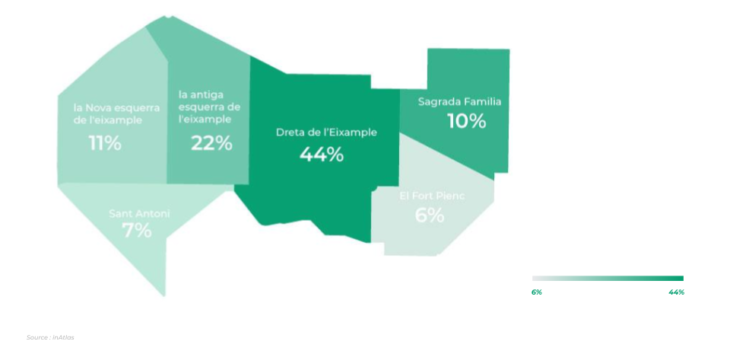
Neighborhood and Street Selection
After concluding that Sant Antoni would be the best neighbourhood to implement our project due to high footfall and less retail activity in creative stores, we chose the area around the street Carrer de Viladomat. Within the neighbourhood the part where the creative stores are more present is the most appealing area. As the project intent is to start with existing stores and then using empty commercial spaces to open new stores and Glovostudios (the spaces that function as a co-working space and store for the local creative designers).
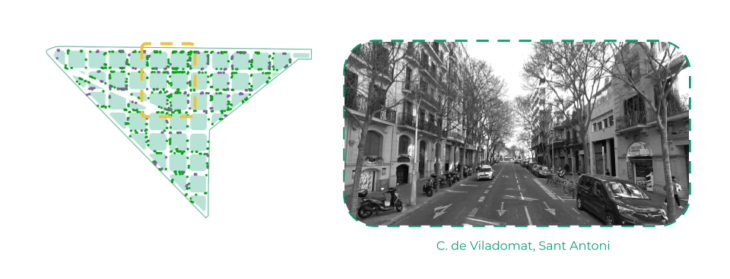
Street as a Shop – Urban Implementation
Projected by Cerda the square blocks and wide streets were used mainly by cars for years. The Superblock implementation changed the vehicle circulation giving more space to pedestrians and alternative mobility solutions like bike. More green areas and more trees were planted increasing the quality of the street. With the implementation of the Street as Shop project the area will be know as new creative design district with lively streets, good acessbillity both physically and digitally.
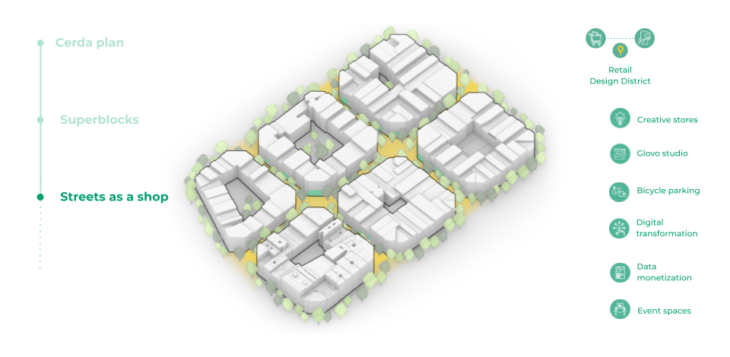
Street Section
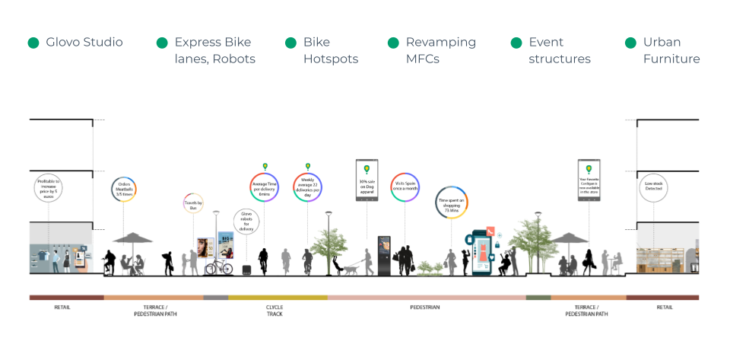
Street as a Shop – Digital Platform
Having the possibility to expand Glovo categories into retail, the creative stores and all the events on the Street as a Shop area are available in users smartphones. This way it becomes possible for consumers to buy all products and have them delivered at their homes, click and collect or even getting access to special discounts as well as information and maps for the hosted temporary events.
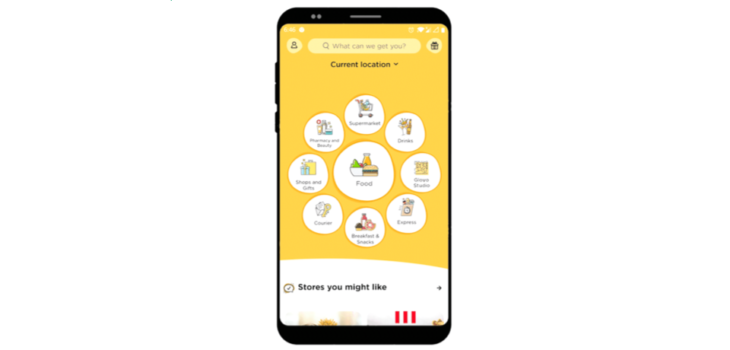
Street as a Shop – Impact and Projections

By applying this local model in a street of Sant Antoni we expect it to be replicated in the Eixample district creating a Desgin District in Barcelona which adds value both at a neighbourhood and city scale. Promoting investment opportunities, increasing commercial interactions and improving the city quality of life with better streets and a better distribution service. Having the street as a shop, retailers, creative designers and citizens have a better and more acessible interaction.
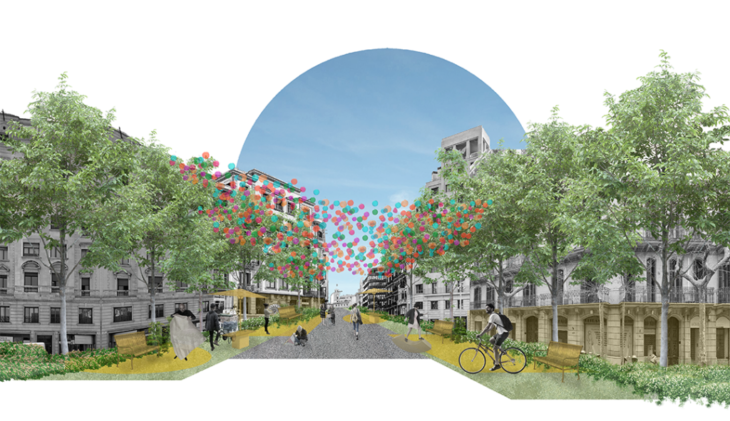
Glovoscapes is a project of IAAC, Institute for Advanced Architecture of Catalonia developed at Master in City & Technology in 2021/22 by students: Kriti Nirmal, Jiyun Lee, Julia Veiga & Yohan Wadia and faculty: Luis Falcon & Iacopo Neri
